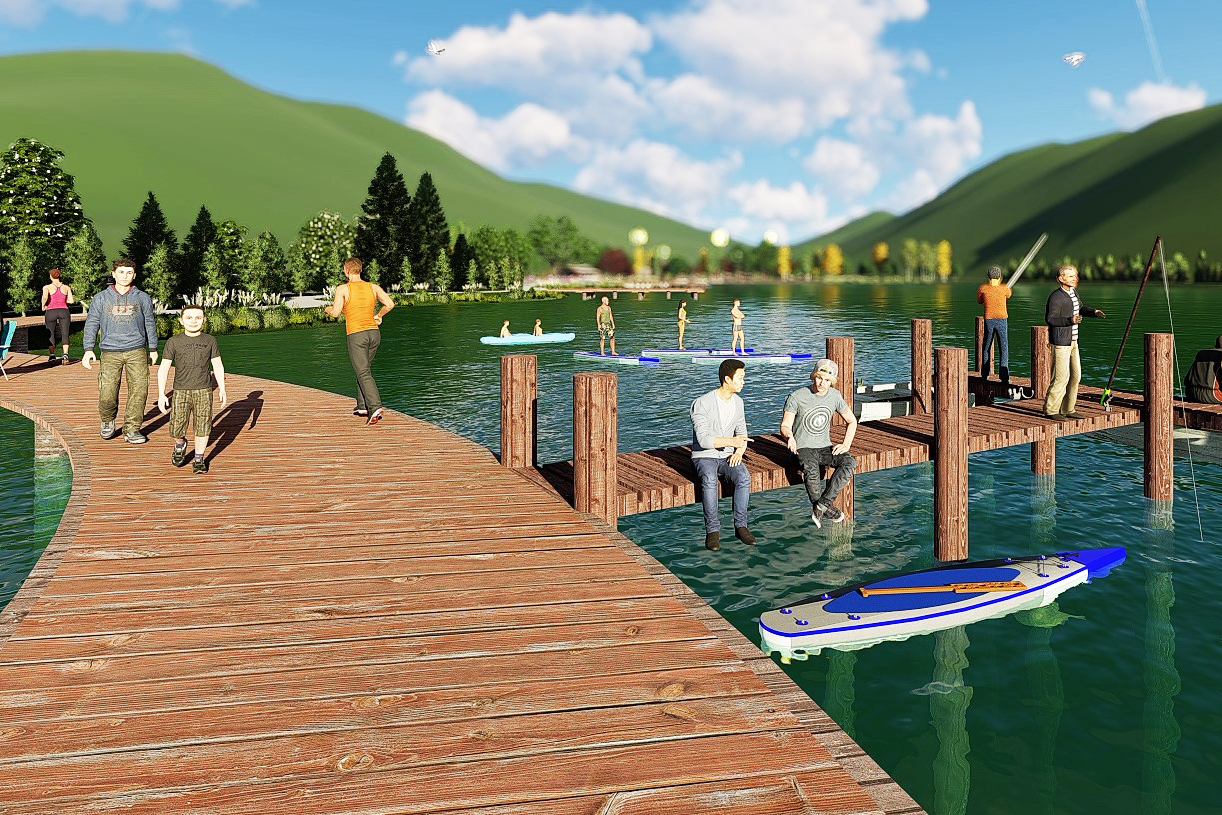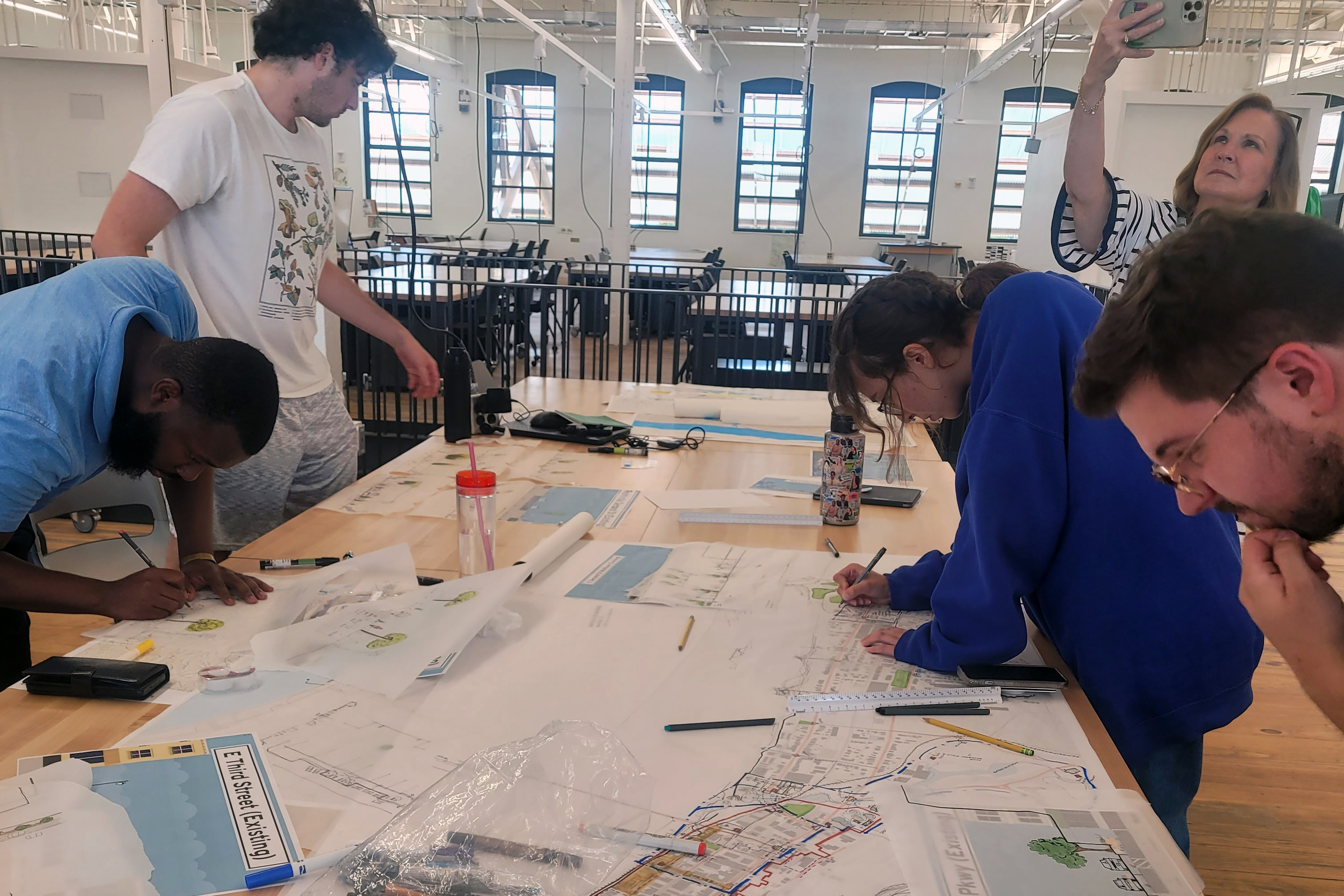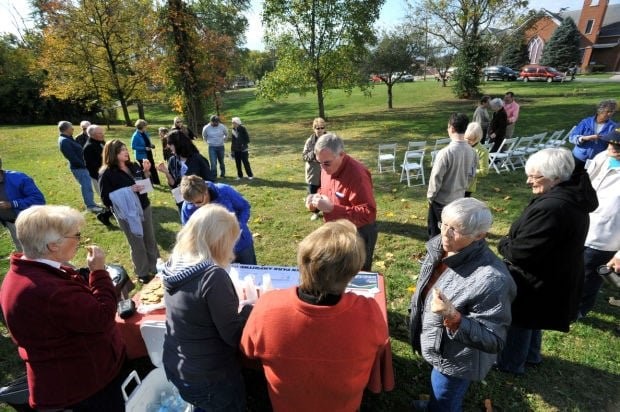Activity Guide | Radical Walking Toolkit
Activity Guide | Radical Walking Toolkit

WHAT'S INCLUDED IN THE TOOLKIT?
- Example of questions a facilitator can use during a Radical Walk.
- Example of a mapping activity.
- Example of a Radical Walking survey questionnaire with emphasis on public spaces and arts.
WHAT IS RADICAL WALKING?
Radical Walking is a process for recapturing our understanding of everyday spaces through slow walking. The initial idea of Radical Walking emerged from the works of a French theorist and philosopher from the mid-20th Century.
We structured Radical Walking as an engagement process and a tool to entice individuals to examine their surroundings. This toolkit provides a youth-focused example of guiding questions, activities and a survey questionnaire that can be utilized to help youth observe, interpret, and voice their ideas for vibrant communities. It can also be used by community leaders to enliven engagement in community and economic development efforts in more creative and holistic ways.
AWARENESS
Neighborhoods have public spaces that belong to everyone, such as streets, sidewalks and parks. Public spaces can also be gathering spots. Sometimes people gather in private spaces such as a place of worship or restaurant; other times they may gather in public spaces and block off streets for parades, musical events or food celebrations. Neighborhoods often have art along their streets and buildings. Sometimes the art is permanent, while in other cases it is only intended to last for a day or two. Input about how people view public spaces in the neighborhood can be an important first step toward creating and sustaining vibrant communities.
EXPLORATION
Radical Walking enables us to examine our surroundings in a more creative way. Our bodies are great collection devices that enable us to use sight, sound, smell, taste and touch to experience and understand our surroundings, while also putting ideas and things together in ways that no man-made device can. Additionally, we can map how emotions, such as fear, pleasure, and joy, are more holistically related to spaces in ways that cannot be captured on a conventional map.
GUIDE FOR FACILITATORS DURING RADICAL WALKING
Storytelling:
Some walkers may have stories about public places in the neighborhood. These stories can provide understanding about the history or sense of place. Follow-up questions could be:
- What parts of the story should be kept alive?
- What parts should be forgotten?
- Is there some kind of action that could or needs to take place?
The Arts:
Some public places are expressions of who we are. On certain days or in particular places, there is music, dance, visual arts, the written word, street theatre or other reflections of our diversity and cultures.
- What kinds of art do you find in the neighborhood?
- What attracts you? Why?
- What do you find disturbing? Why?
- What kind of artistic expressions would you like to see? Why? Where?
- What are the artistic or cultural strengths of the neighborhood that you would like to see enhanced? How? Where?
- If you could change something for a day, a weekend or a week, what would you like to see happen?
Ways to Use Radical Walking Approaches:
- Build a sense of delight and pleasure into understanding the opportunities, challenges or changes needed for neighborhood public spaces.
- Contrast data collection with each other and other groups for a better understanding about how they differ or agree.
- Groups may develop their own action plan and carry it out.
- Stimulate deep discussion about changes needed in neighborhood identification (for example, what smells need to be enhanced or minimized?).
- Strengthen the sense of neighborhood togetherness.
Roles of Facilitators for Radical Walks:
- Facilitators recruit their peers to go on walks.
- Facilitators should be neutral guides. They should ask questions that are unbiased. Let people talk about public spaces as they see fit.
- For example, a facilitator might ask: “How do you feel about this mural?” or “What do you like or dislike about how this park is used?”
AVOID biased questions such as: “Do you hate this mural as much as I do? or “Don’t you think we should clean up this park?”
After Radical Walking:
- Participants complete a short survey about public spaces in the neighborhood. Each survey is confidential and anonymous. The surveys should be returned to the project leader/facilitator.
- After surveys are completed and gathered, participants may have a conversation about what they experienced during the walk. They may summarize their experiences through a sticky-note activity, group drawing, a short skit or some other approach. They might also decide to take some kind of action as a group or partner with other groups.
- Project leaders/facilitators should ask what the group has decided to do in order to provide additional assistance if needed. The walks are intended to build democratic participation and a greater sense of neighborhood identity.
The survey information can be used to note the similarities and differences regarding the use of public spaces. Compilation of information should be presented back to participants to further guide discussions that can lead to community-based action about public spaces in the neighborhood.
GUIDING QUESTIONS DURING RADICAL WALKING
Take a leisurely walk with a group through the neighborhood’s public spaces. It is often best if people can organize themselves into groups of three or four. During your walk, use the five senses: touching, smelling, seeing, hearing and tasting. The body has emotions associated with the senses. Note the emotions that are triggered as you use your senses in the neighborhood. Facilitators can guide group discussions along the walk to trigger discussion for the betterment of their neighborhoods. The following are some example questions corresponding to our five senses.
Questions guiding the sensory examination of public spaces:
VISUAL-SCAPE
- What do you see without judging the neighborhood?
- What did you expect to see?
- What surprised, amused or frightened you?
- What did you see that was beautiful or has the potential for beauty?
Future
- What do you want to see in the neighborhood?
- What pleasant views of the neighborhood public spaces would you like to share with people?
TOUCH-SCAPE
- What do you feel if you rub against built or natural places in the landscape?
- What do you feel when your feet touch the pavement, grass or dirt?
- What does the touch of the bark on a tree, fence, wall or fountain feel like?
- What happens when you experience people, animals or insects touching you or not touching you?
- What emotions do these touches trigger?
- If you led a blind person in the neighborhood, what would you want them to touch?
Future
- What would you like your feet to touch?
- What would you change about the built or natural environment that would encourage people to touch?
SOUND-SCAPE
- What do you hear?
- What sounds are unexpected, the most pleasant or interesting?
- Are there sounds in the neighborhood that trigger different kinds of emotions?
- What are those emotions?
- If you could develop a sound map of the neighborhood, what would it look like?
Future
- What would you like to hear in a certain public space; for example, a poem, play, speech or certain kind of music?
- Are there opportunities for sounds to be experienced at greater or lesser levels?
SMELL-SCAPE
- What kinds of odors do you smell in the neighborhood?
- What smells triggered your emotions?
- What would a smell-scape map look like?
Future
- What would you like to smell in a certain public space?
- Are there opportunities to enhance or minimize certain smells to strengthen our neighborhood?
TASTE-SCAPE
- What do you taste during the walk?
- What tastes surprised you?
Future
- What tastes can be enhanced or added to the neighborhood?
- What would you like to tell people about the tastes of the neighborhood public spaces?
RADICAL WALKING: PUBLIC SPACES AND ARTS SURVEY
Hello! I am [Name of Community Facilitator], a [title and organization, otherwise resident or volunteer]. Now that you have explored [Name of Community/Neighborhood], I am interested in what you experienced, and hope to see changed in the public spaces of [your neighborhood] in the future.
Your participation is completely voluntary and all responses are anonymous. Your responses will help the [Name of organization/ Community/Neighborhood] so we can use and support your ideas for public spaces and arts endeavors. All of your responses are extremely important and valuable.
The survey should take about 20 minutes to complete, and we believe you will find it fun and interesting to do. Please finish the survey and return it in your facilitator. If you have any questions afterwards, feel free to contact [Name of facilitator] at [phone number] or [email].
[Insert Map of your Community Public Spaces, and highlight suggested walking route]
Walking in the Public Spaces – Your Senses
Now, think about your walk in the [Name of Community] neighborhood. Public spaces include streets, sidewalks, parks and public buildings such as [Name of Park, Name of Street(s)], and so on.
What would you like to see in the public spaces in the future?
What public space features or arts would you like people to be able to touch in the future? (for example, seating, signs, sculpture, and so on)
What would you like to hear in the public spaces in the future?
What would you like to smell in the public spaces in the future?
What public space features or arts would you like people to be able to taste in the future? (for example, sweet taste in air near a candy factory or bakery)
Public Spaces
Public spaces include parks, streets, sidewalks, and public buildings.
How often do you go out to public spaces in the [Name of Community/Neighborhood] neighborhood?
Everyday=4, Often=3 (2-3 days/week), Sometimes=2 (2-7 days/month), Not Much=1
(Assign each type of space a number that corresponds to your answer)
- Parks:
- Streets:
- Sidewalks:
- Public Buildings:
What do you like the most about each of these public spaces?
- Parks:
- Streets:
- Sidewalks:
- Public Buildings:
What kind of activities do you usually do when you are outside in the [Name of Community/Neighborhood] neighborhood area? (Circle all that apply)
- Walking,
- Jogging/Running,
- Sports Activities,
- Picnicking,
- Bicycling,
- Attend Events,
- Skateboarding,
- Hanging Out (in group),
- Dining with Family/Friends,
- Other
How do you move around in the [Name of Community/ Neighborhood] neighborhood, and how convenient is it to move around? (Check all modes that you use, AND rate how convenient it is to travel for each mode) Easy=5, Somewhat Easy=4, Average=3, Somewhat Difficult=2, Difficult=1
- On Foot:
- In a Car:
- On a Public Bus:
- On a Bike:
What do you like about how public spaces are used in the neighborhood?
What do you dislike about how public spaces are used in the neighborhood?
Where or what are your favorite outdoor areas in the neighborhood?
What is your favorite event that has taken place in a public space in the neighborhood?
Why do you like those particular space(s) or place(s)? (Circle all that apply)
- Layout of space,
- Convenient location,
- Openness,
- Existing cultural/historical features,
- Variety of diverse natural features,
- Opportunities for sports activities,
- Pleasant view,
- Other
Public Spaces and the Arts
How appealing are the public spaces in the [Name of Community/Neighborhood] neighborhood?
Most Appealing=5, Somewhat Appealing=4, Average=3, Somewhat Unappealing=2, Least Appealing=1
(Assign each type of space a number that corresponds to your answer)
- Parks:
- Streets:
- Sidewalks:
- Public Buildings:
Do we need to change anything about the use of public spaces in this neighborhood that will make us better people? YES, NO, MAYBE
What would you like to see changed in the public spaces in [Name of Community/Neighborhood]?
- More street trees,
- New paved sidewalks,
- More street lights,
- Preserved cultural/historical features,
- Variety of natural features,
- More space for sports activities,
- Pleasant view,
- Other
What should we redesign in the public spaces to make the neighborhood a better place (even if it is for only one day)? (You may draw or write out your answer. You may be as creative as you wish. If you need more space, please ask and we will provide you with more paper.)
What physical/landscape feature(s) or programs would you like to see included in [Name of Community/ Neighborhood] public spaces?
Much More=5, a Few More=4, No Change=3, a Few Less=2, Much Less=1
(Assign each type of feature or program a number that corresponds to your answer)
- Interactive features:
- Variety of seating options:
- Shade:
- Sculptures:
- Efficient signs:
- Other businesses:
- Smooth sidewalks:
- Murals or paintings:
- Any other ideas not listed above:
What do you think is important about [Name of Community/Neighborhood]? (Check all that apply)
- It is close to [another location].
- It has places for me to go outdoors.
- There are many natural features to observe.
- There are many cultural/historical features.
- I like my neighborhood because I live and/or go to school/work here.
- Any other examples not listed above:
How will [Name of Community/Neighborhood] benefit from improvements to the public spaces? (Check all that apply)
- It will be a more pleasant place to live, work, learn and play.
- It could increase economic opportunities for the neighborhood.
- It could increase the variety of natural features and habitat(s).
- It could preserve various cultural/historical features for the future.
- It could become a place where friends, family or visitors gather, meet or converse.
- Any other examples not listed above:
Write down any more ideas you have on how to improve the public spaces in the [Name of Community/ Neighborhood] neighborhood?
(Please draw or sketch ideas for the neighborhood below. If you need more space, please ask and we will provide you with more paper.)
How are you associated with the [Name of Community/ Neighborhood] neighborhood? (for example, residents, students, business owner, or visitor)
Do you live in the [Name of Community/Neighborhood] neighborhood? YES, NO, KIND OF
What is your gender?
What time did you participate in the walk? AM PM


